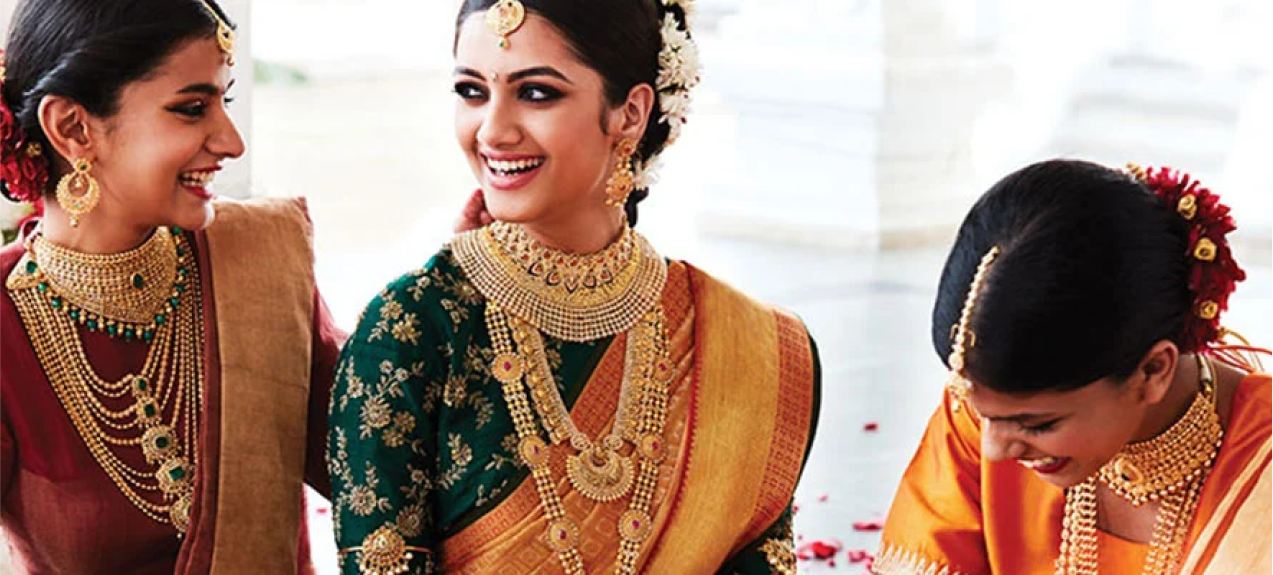From the Nischayathartham to the wedding reception, a Telugu bride (and groom for that matter) has to participate in several rituals. These rituals are a rite of passage, passed down over generations, and aim to create a strong bond between the bride, groom, and their families. We dive into the customs and traditions that make up a Telugu wedding ceremony, the age-old rituals to the playful ring game.
The Engagement: Beginning of a Telugu Wedding
The Telugu engagement, known as Nischayathartham, marks the start of the wedding celebrations. The bride, adorned with a Telugu bridal jewellery set, and her groom, in his finest, express their commitment.
Tanishq’s vibrant traditional necklace set, with its exquisite craftsmanship, is perfect for this occasion. The elegant gold pendants and matching earrings make the bride look regal and radiate cultural pride.
The Purifying Paste: Pellikuthuru Ceremony in Telugu Wedding Rituals
Pellikuthuru is a joyous pre-wedding ritual where family and friends apply turmeric paste – made from turmeric, sandalwood, rose water, and other natural ingredients – on the bride’s body to purify her and ensure glowing skin.
The bride’s attire is complemented with traditional gold ornaments for ladies, including a delicate gold bracelet and small gold stud earrings, enhancing her natural beauty.
A perfect example is the gold jewellery with lehenga collection that perfectly matches the warmth of turmeric and the festival atmosphere.
The Blessed Bath: Mangala Snanam in Telugu Marriage Rituals
Marying the auspiciousness, the bride and groom are splashed with holy water, milk, curd, honey, and turmeric in their respective homes. The custom – Mangala Snanam – signifies purification and blessing for a happy marriage.
The bride’s traditional south Indian jewellery collection includes a south Indian necklace, which beautifully echoes the spiritual significance of this ritual.
A simple yet elegant pendant set gold new design can beautifully complement her look.
The Puja
During the various puja ceremonies, the bride wears her south Indian jewellery, including items like the Vaddanam (waist belt), maang tikka, and temple jewellery. The intricate design of her south Indian jewellery set for wedding highlights the region’s artistry and religious ethos.
Tanishq’s collection of south Indian jewellery design perfectly captures this traditional essence while giving brides a contemporary edge.
The Exchange: Core Telugu Marriage Rituals
The main wedding ritual involves the exchange of vows – Kanyadanam and Panigrahanam. The bride is dressed in a heavily ornamented south Indian bridal jewellery set, featuring a broad gold necklace, south Indian chain design, and intricate earrings.
Her look is complete with a south Indian necklace set from Tanishq, adorned with motifs symbolising prosperity. The bride looks resplendent with a gold haaram and a matching south Indian jewellery set that reflects her heritage beautifully.
The Reception
Post-ceremony, the bride dazzles in a saree or lehenga coupled with a south Indian jewellery set for wedding. Her look is finished with beautifully crafted south Indian jewellery design and Timeless Floral Bangles, and her south Indian saree jewellery complements her radiant smile.
A modern touch could include the latest designs in south Indian jewellery for a fresh, youthful vibe.
She embraces her new beginning with sparkle, grace, and cultural pride – ready to make memories that last a lifetime.
Conclusion
The Telugu wedding is an intricate tapestry of culture, tradition, and love, reflected beautifully through the symbolism of jewellery. From the engagement to the reception, every piece of jewellery is carefully selected to tell a story of heritage and hope.
Tanishq’s curated collection of Telugu wedding jewellery offers timeless pieces that embody this rich legacy, ensuring every bride looks and feels regal on her special day.
Tanishq Tips:
- Choose jewellery that complements your skin tone and attire to achieve a harmonious look.
- Incorporate traditional motifs and brilliant jhumkas with modern designs for a personalized touch that reflects your unique style.


 GET THE APP
GET THE APP







